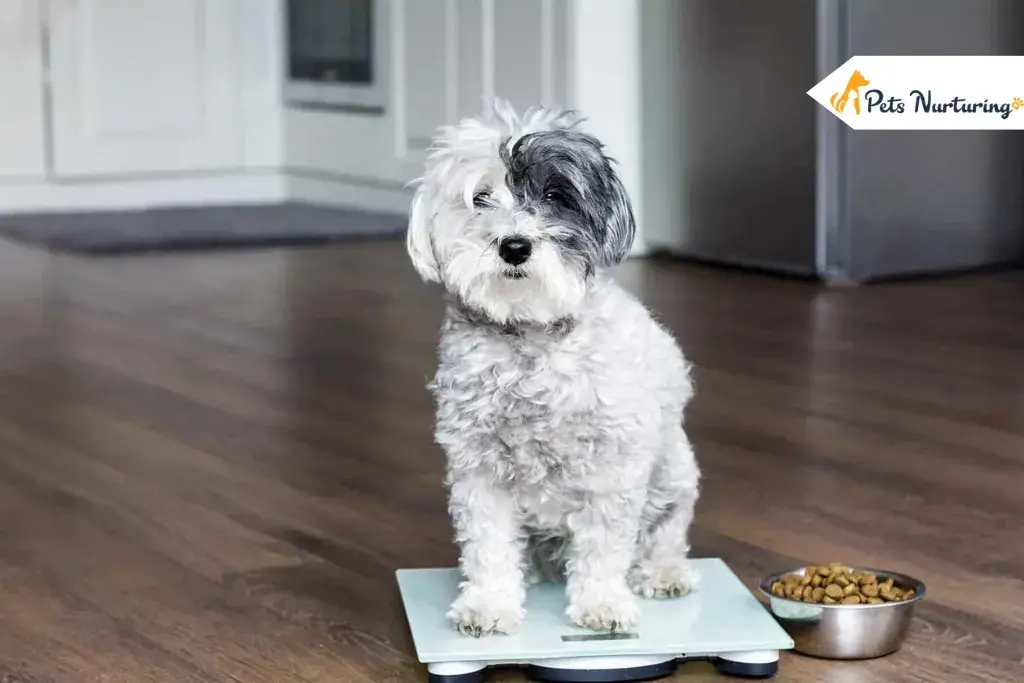
How Heavy Should My Dog Be – Know Here How to Determine the Ideal Dog’s Weight.
Whether you recently became a dog owner or have had pets for many years, this is a common question that every pet owner has in mind.
Regardless of your dog’s breed, it’s vital to know how heavy should my dog be. This includes a dog’s height, weight, health condition, and other factors.
These simple questions can really give you a brief about your canine’s health. This means if your answer is ottoman, sadly, your puppy is overweight, even obese. On the other hand, if you see your dog’s bones and skinny body structure, this means your pet is underweight.
Both are health conditions, and if not properly taken care of, they can lead to serious issues and canine diseases. This is why it’s crucial for all dog owners to keep their dogs at a healthy weight.
Don’t know how to do this? No worries, keep reading!
We’re here with a complete dog weight guide. Today we’ll tell you everything about dogs weight charts. From how much is an ideal dog’s weight to how to calculate your dog’s weight, we’ve covered every important detail. So, don’t skip anything and read till the end.
Let’s start.
How Much Should My Dog Weigh?
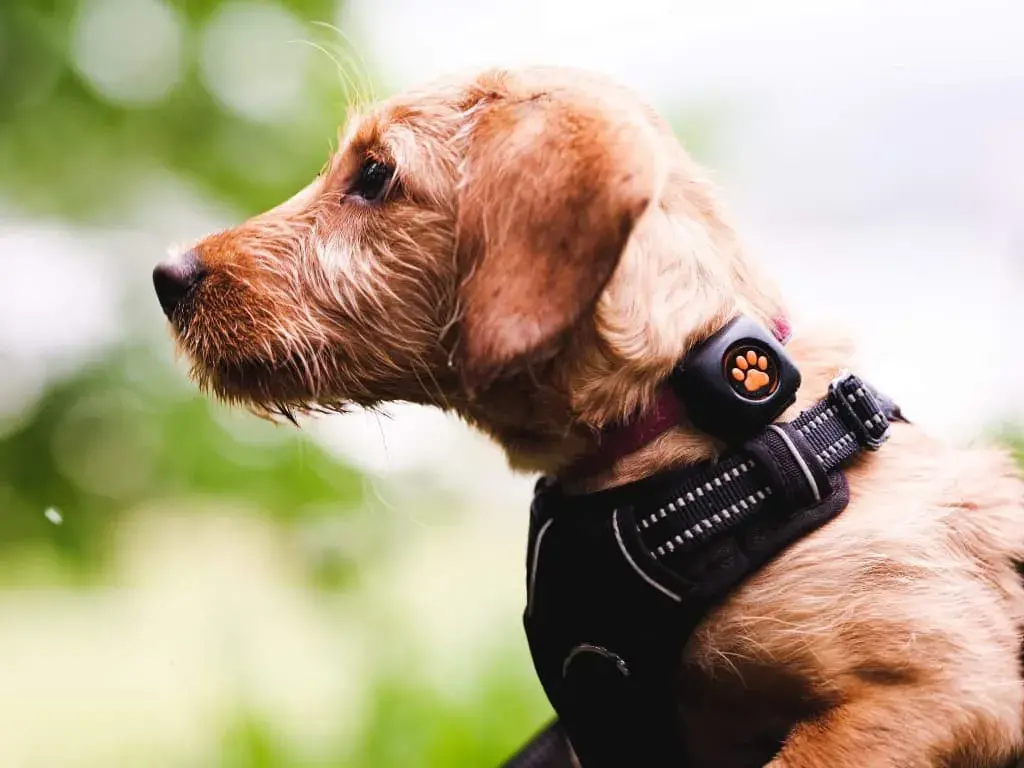
The ideal dog’s weight basically depends on several factors, such as body type, size, and gender. Currently, 339 breeds of dogs are legally registered in the Fédération Cynologique Internationale (FCI), and over 199 dog breeds are recognized by the American Kennel Club (AKC).
Every breed has different body sizes and types, so it’s quite impossible to determine the exact ideal weight. And besides these pure breeds, there are also mixed breeds which makes this thing even harder.
Other than these three factors, there are other elements like the season, stress levels, and activity levels.
Body Condition Scoring System (BCS)
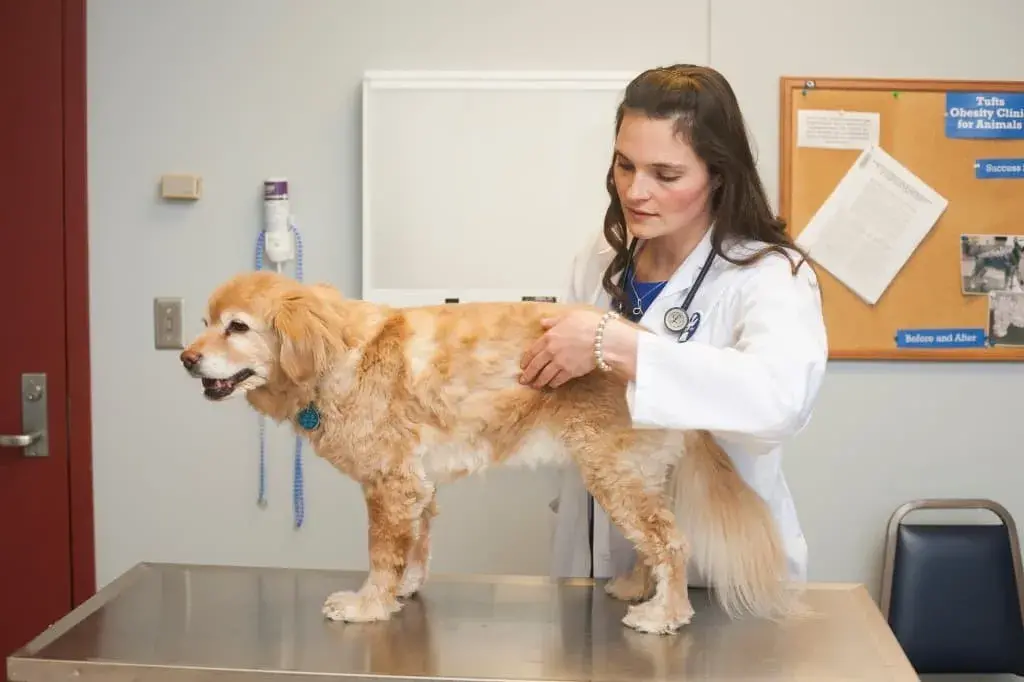
The Body Condition Scoring System (BCS) is a popular method of calculating a dog’s weight. BCS can help you determine whether your pup is too thin, healthy, or overweight.
Most veterinary clinics widely use BCS to evaluate the overall stature of a pet. In this procedure, the vet will examine a canine’s ribs, abdomen, and waistline by sight and touch or the overall amount of body fat. The results will be the score, which will accurately tell the weight.
Here’s the score chart:
- 1-3 = Underweight (too thin)
- 4-5 = Ideal weight
- 6-9 = Overweight to obese (too heavy)
Muscle Condition Scoring (MCS)
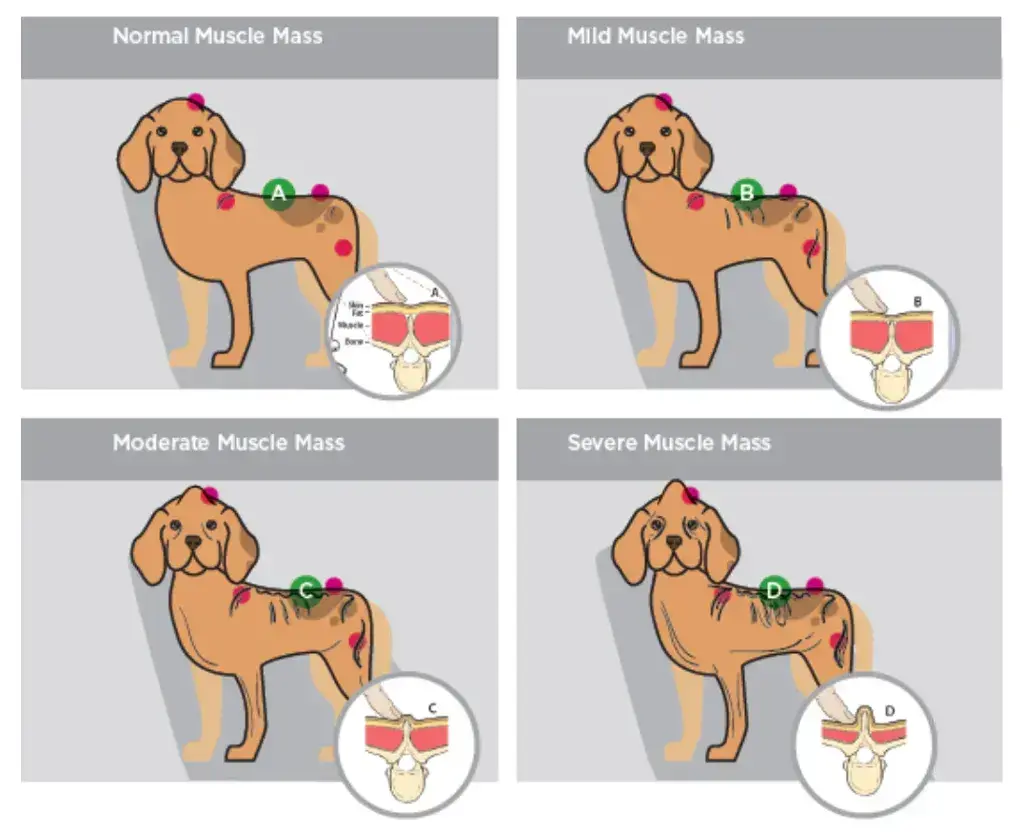
Muscle Condition Scoring (MCS) is another way of calculating a pet’s weight. This method evaluates muscles, spine, shoulders, head, and hips. This will assess muscle loss.
With growing age, animals tend to lose muscle mass. However, this also happens because of underlying diseases such as obesity. In some cases, even the pet is not obese or appears less obese from the outside, but in reality, they’re unhealthy from the inside. Through the MCS, we can calculate muscle loss in canines.
However, BCS and the MCS are not directly related!
Dog Weight Chart (By Breed)
How Heavy Should My Dog Be?
Starting with the BCS method is a great way to determine whether your furry companion has a healthy weight or not. You can start with a dog’s weight chart to get a general idea.
Here is the dog weight chart by breed:
| Breed | Average Weight Range |
| Afghan Hounds | 50-60 lbs |
| Airdale Terriers | 40- 65 lbs |
| Akitas | 70-120 lbs |
| Alaskan Malamutes | 75-85 lbs |
| American Staffordshire Terriers | 55-65 lbs |
| Australian Cattle Dogs | 30-35 lbs |
| Australian Shepherds | 40-65 lbs |
| Basenjis | 20-25 lbs |
| Basset Hounds | 40-60 lbs |
| Beagles | 18-30 lbs |
| Bearded Collies | 45-55 lbs |
| Belgian Malinois | 55-75 lbs |
| Bernese Mountain Dogs | 75-110 lbs |
| Bichon Frises | 10-16 lb |
| Black And Tan Coonhounds | 65-110 lbs |
| Bloodhounds | 80-110 lbs |
| Border Collies | 30-45 lbs |
| Border Terriers | 11-15 lbs |
| Boston Terriers | 10-25 lbs |
| Bouvier Des Flanders | 70-110 lbs |
| Boxers | 50-75 lbs |
| Brittany Spaniels | 30-40 lbs |
| Brussels Griffons | 8-10 lbs |
| Bulldogs | 40-50 lbs |
| Bullmastiffs | 100-130 lbs |
| Bull Terriers | 50-70 lbs |
| Bull Terriers (Miniature) | 24-32 lbs |
| Cairn Terriers | 12-16 lbs |
| Cardigan Welsh Corgis | 24-38 lbs |
| Cavalier King Charles Spaniels | 13-18 lbs |
| Chihuahuas | 4-6 lbs |
| Chinese Crested | 8-12 lbs |
| Chinese Shar-Peis | 45-60 lbs |
| Chow Chows | 45-70 lbs |
| Cockapoos | 12-24 lbs |
| Cocker Spaniels | 26-34 lbs |
| Collies | 50-75 lbs |
| Dachshunds (Standard) | 16-32 lbs |
| Dachshunds (Miniature) | 8-10 lbs |
| Dalmatians | 45-75 lbs |
| Doberman Pinschers | 60-95 lbs |
| English Cocker Spaniels | 26-34 lbs |
| English Setters | 45-80 lbs |
| English Springer Spaniels | 40-50 lbs |
| Flat-Coated Retrievers | 60-70 lbs |
| Fox Terriers | 16-18 lbs |
| French Bulldogs | 19-28 lbs |
| German Shepherds | 50-90 lbs |
| German Shorthair Pointers | 45-75 lbs |
| Goldendoodles (Miniature) | 15-30 lbs |
| Goldendoodles (Standard) | 40-50 lbs |
| Golden Retrievers | 55-75 lbs |
| Gordon Setters | 45-80 lbs |
| Great Danes | 110-175 lbs |
| Great Pyrenees | 85-125 lbs |
| Greyhounds | 60-70 lbs |
| Havanese | 7-13 lbs |
| Irish Setters | 60-70 lbs |
| Irish Terriers | 25-27 lbs |
| Irish Wolfhounds | 105-120 lbs |
| Italian Greyhounds | 7-14 lbs |
| Jack Russell Terriers | 14-18 lbs |
| Keeshonds | 35-45 lbs |
| Labrador Retrievers | 55-80 lbs |
| Labradoodles | 50-65 lbs |
| Labradoodles (Miniature) | 15-25 lbs |
| Lhasa Apsos | 12-18 lbs |
| Maltese | 4-6 lbs |
| Mastiffs | 120-200 lbs |
| Miniature Pinschers | 8-10 lbs |
| Newfoundlands | 100-150 lbs |
| Norwegian Elkhounds | 48-55 lbs |
| Norwich Terriers | 10-12 lbs |
| Old English Sheepdogs | 60-100 lbs |
| Papillons | 7-10 lbs |
| Pekingese | 6-10 lbs |
| Pembroke Welsh Corgis | 25-30 lbs |
| Pomeranians | 3-7 lbs |
| Pomsky | 20-30 lbs |
| Poodle (Standard) | 45-70 lbs |
| Poodle (Miniature) | 10-15 lbs |
| Poodle (Toy) | 4-6 lbs |
| Portuguese Water Dogs | 35-60 lbs |
| Pugs | 14-18 lbs |
| Puggles | 15-30 lbs |
| Rat Terriers | 10-25 lbs |
| Rhodesian Ridgebacks | 70-85 lbs |
| Rottweilers | 80-130 lbs |
| St. Bernards | 120-180 lbs |
| Samoyeds | 35-65 lbs |
| Schipperkes | 10-16 lbs |
| Schnauzer (Giant) | 55-85 lbs |
| Schnauzer (Standard) | 30-45 lbs |
| Schnauzer (Miniature) | 12-15 lbs |
| Scottish Terriers | 18-22 lbs |
| Shetland Sheep Dogs | 18-20 lbs |
| Shiba Inus | 17-23 lbs |
| Shih Tzus | 9-16 lbs |
| Siberian Huskies | 35-60 lbs |
| Silky Terriers | 8-10 lbs |
| Staffordshire Bull Terriers | 24-38 lbs |
| Tibetan Terriers | 18-30 lbs |
| Toy Fox Terriers | 4-7 lbs |
| Vizslas | 45-60 lbs |
| Weimaraners | 55-85 lbs |
| Welsh Terriers | 18-20 lbs |
| West Highland Terriers | 15-21 lbs |
| Whippets | 25-40 lbs |
| Wirehaired Pointing Griffons | 40-60 lbs |
| Yorkshire Terriers | 4-7 lbs |
| Yorkshire Terriers (Teacup) | 1-3 lbs |
NOTE:
This is an alphabetical chart that doesn’t cover all the breeds around the globe. Also, keep in mind that female dogs have a lower weight than male ones. So, the weight depends on the factor of what age do dogs stop growing. For a more detailed breed weight chart, visit AKC Breed Weight Chart.
How to Calculate Dog’s Weight?
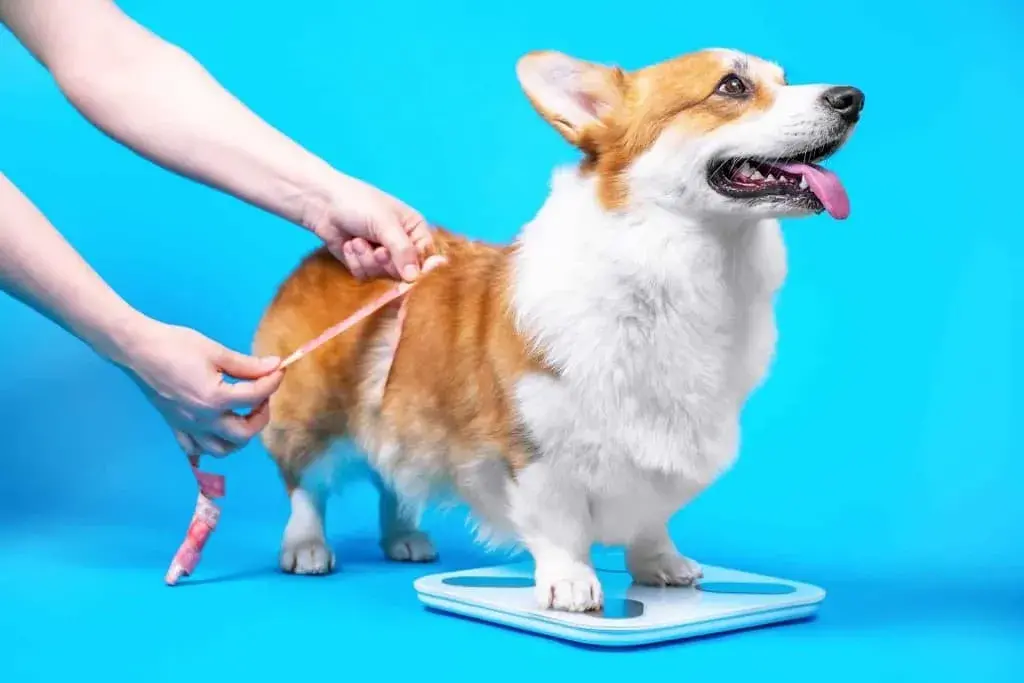
Here is how to calculate your dog’s healthy weight:
First, it’s important to know the BCS. after knowing the right BCS; you can move forward to calculate the dog’s target weight.
Below is the step-by-step method to figure out the target weight:
The dog weight formula:

Let’s take a 50-pound dog as an example and put the numbers in the formula:

| Steps | Example: 50-lb. dog with BCS of 9 |
| 1. Take your dog’s starting BCS and subtract 5. | 9-5 = 4 |
| 2. Multiply that number by 10. | 4 x 10 = 40 |
| 3. Add 100. | 40 + 100 = 140 |
| 4. Divide 100 by the result from Step 3 then round it to 3 digits. | 100 / 140 = .714 |
| 5. Multiply that by your dog’s current weight. | .714 x 50 pounds = 35.7 pounds |
| Dog’s Target Weight: | 35.7 pounds |
Similarly, you can determine your dog’s weight by putting the right BCS value.
How To Check Your Dog’s Body Condition At Home

Don’t know how to calculate the dog’s body condition?
Here’s the video tutorial to figure out your pup’s body condition.
Why Is Maintaining Your Dog’s Weight So Important?
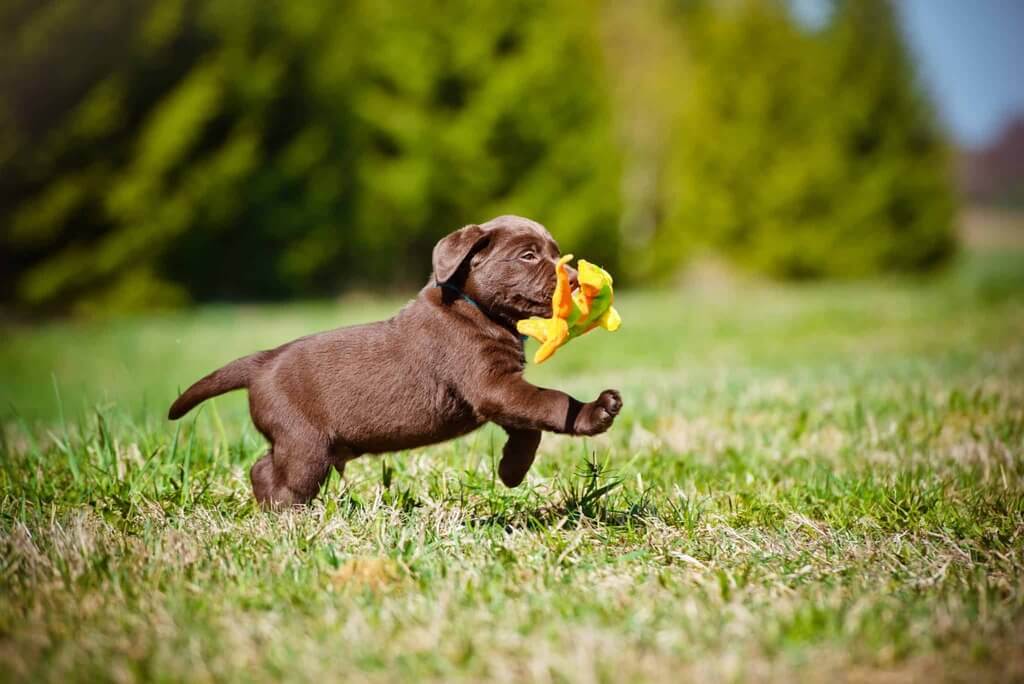
After reading here, you get an idea about the importance of the dog’s weight, but is it really necessary? Yes, it is!
In 2021, the Association for Pet Obesity Prevention (APOP) surveyed pet parents, which showed “only 39% of pet parents said they considered their dog overweight or obese.”
However, the statistics tell a completely different story!
Another survey from Veterinary Clinic Prevalence by APOP in 2018 found that “an alarming 55.8% of dogs were classified as clinically overweight or obese.”
If you search on Google, you will get many surveys and research reports on dogs being overweight, with shocking results and findings.
This is because many pet owners don’t realize that their beloved pets are obese or suffering from obesity! What do you think about this?
This can lead to several medical issues, including:
- Orthopedic diseases, like osteoarthritis
- Kidney dysfunction
- Skin problems
- Reduced life expectancy
- Respiratory disorders
- Cancer
- Heart problems
- Chronic inflammation
- Diminished quality of life
What If My Dog Is Underweight?

If your pup is too thin or after calculating your dog’s weight through BCS the score comes between 1 to 3, this means that your dog is underweight. If your canine friend isn’t eating enough, you should consult your nearest vet immediately. This is a serious health problem; your vet will determine the real reason behind this.
They will examine the dog carefully and will tell you whether it happens due to an underlying health problem or if your pup has any other medical issues.
Here are some of the medical conditions:
- Intestinal Parasites
- Stress
- Diabetes
- Cancer
- Kidney Disease
- Addison’s Disease
- Dental Disease
- Gastrointestinal Problems, and many more.
Insufficient Diet
Another reason your dog seems underweight is that they aren’t getting the essential nutrients and calories needed. This is why you should always give your pup high-quality dog food with all the necessary proteins and nutrients. This will help your canine to gain a healthy weight.
Your Dog Is a Picky Eater
You tried everything, but your dog is just not ready to eat everything. This means your buddy is a picky eater. And now it’s time to change the dog food. Try different types of foods like wet or dry foods. You can also add other ingredients, such as including fresh meals, personalized premium kibble, and more. This is a great guide for food for fussy dogs if you need extra guidance.
What If My Dog Is Overweight?

If you feel your beloved dog has more weight than it should be, this is a thing to get concerned about. Little belly fat indeed makes your puppy adorably cute, but this can also put his life at risk.
There are many risks for your pets if they’re overweight or obese:
- Back Problems
- Arthritis
- Inflammation
- Shorter Life Span
Tips For Overweight Dogs
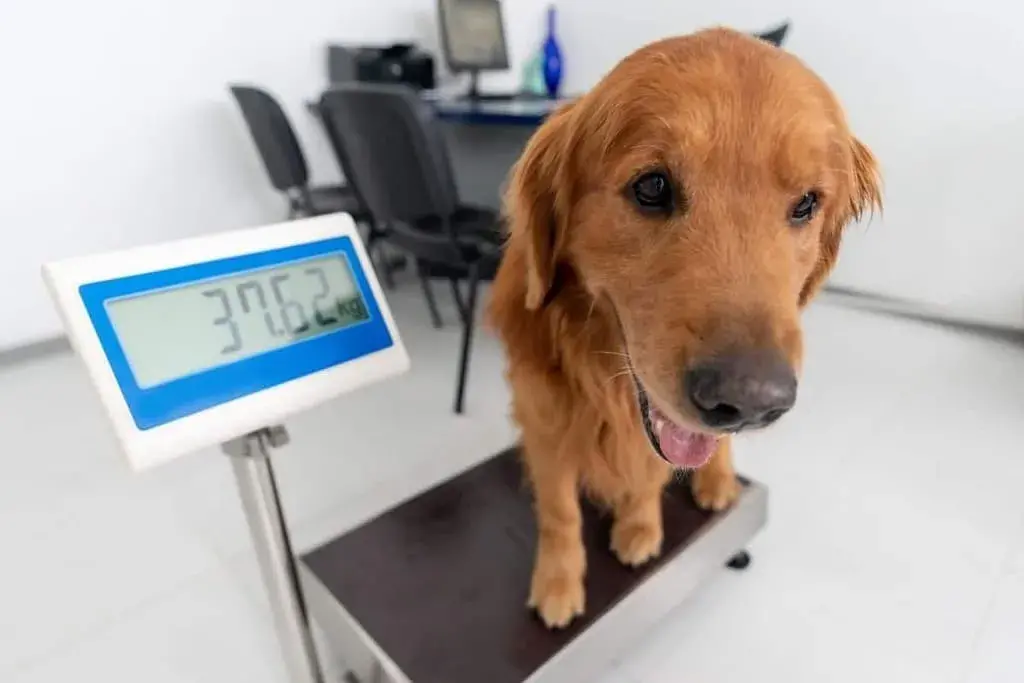
If you think your dog is obese or has recently gained a few extra pounds, it’s time to pay attention to his diet. By providing a proper and healthy diet, you can help your pup to lose weight.
There are many easy and effective ways in which your pet can easily lose weight, such as:
- Playtime
- Exercise
- Physical Activities
- Healthy Treats
With the help of simple but fun activities, you can easily control your pooch’s weight. Besides putting him on a diet, get him to do more exercise. You can also consult your vet. They will check your dog, and according to his current health conditions, they will develop a weight loss diet plan for him.
Important Note on Dog’s Weight!
Average Dog Weight is a Myth!
Keep in mind that no two breeds or even no two dogs are exactly similar! As you have already seen in the above breed weight chart, every breed has different body sizes and conditions. You can’t compare all the dogs under the same conditions or weight measurements.
Just because the dog’s ribs are visible or easy to touch doesn’t necessarily mean he is underweight. This is why it is crucial to get a consultation from a Veterinarian. They will properly examine and then tell you the right condition of your puppy.

Conclusion:
After reading this blog on how heavy should my dog be, you’ll surely get the answer to the above question. You can easily calculate the weight of your pup with the above charts and tables, or you can also use the dog weight calculator online. Also, don’t make direct changes to the diet after getting the result. It’s vital to consult your vet and ask them properly about the overall health of your pup. And according to that, you make changes to the diet and lifestyle of your beloved puppy.
I hope this in-depth guide on how heavy should my dog be has helped you to understand the importance of the dog’s weight. If you find this post helpful and informative, share it with your friends and family looking for information about dog weight.
To find out more:











